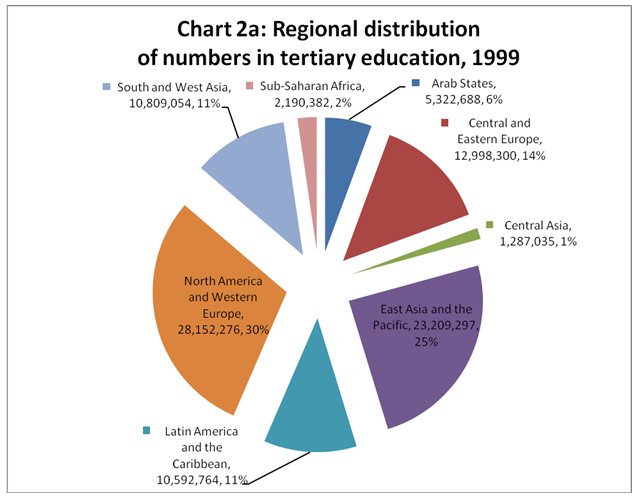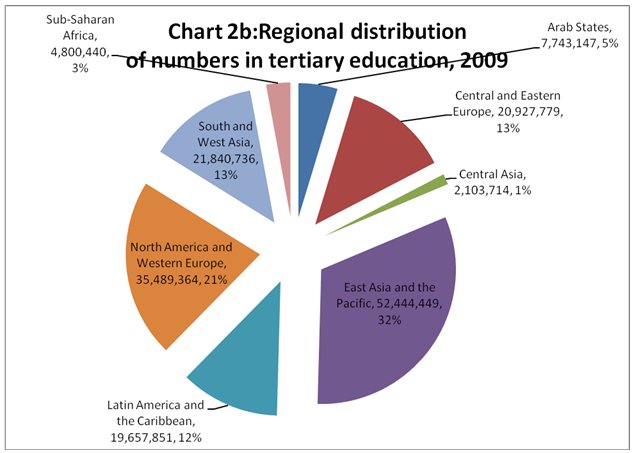Things seem to be improving in education in developing
countries, at least as far as enrolment is concerned.
Across the world, literacy rates have gone up, school
enrolment rates are rising and dropout rates are falling.
Much of the improvement has taken place in the regions
that most needed it, in relatively low income countries
that previously had very low enrolment ratios. Improvements
in educational outcomes have been particularly marked
for girls and young women, so gender gaps are falling.
In some regions, gender gaps have even been reversed,
even in tertiary education which was traditionally
the hardest gap to bridge.
This is clearly good news, even if critics can point
out that in several parts of the world these improvements
are still nowhere near fast enough. And of course
the bare fact of enrolment tells us very little about
the quality of education and its relevance for both
those being educated and for the society. Even so,
increasing enrolment is an important first step.
What is particularly interesting in several developing
regions, including the most populous parts of the
world, is that there has also been significant increase
in tertiary education. Once again, this is good news.
But it does have implications for the future that
are still inadequately analysed.
UNESCO data on enrolment in education provide some
relevant indicators. Chart 1 shows the enrolments
in tertiary education by region. The first point to
note is that while globally tertiary enrolment rates
have been rising, regional differences still remain
dramatic. These spatial variations are possibly even
more marked within the developing world than globally.
Thus, tertiary enrolment rates have been rising fairly
rapidly in Latin America and the Caribbean as well
as East Asia and the Pacific, but much more slowly
in the Arab States and in Sub-Saharan Africa.

Chart
1 >> Click
to Enlarge
Despite
the recent increases in such enrolment in east Asia
(and to a lesser extent South Asia), higher education
enrolment in these regions still remains at less than
half the rates achieved in Europe and North America,
and also still well below other developing regions
like Latin America. What that in turn suggests is
that - especially in the more rapidly growing regions
- higher education enrolment rates will increase even
more sharply in the near future.
This is significant simply because these are the regions
with very large populations and especially with large
(and mostly growing) numbers of youth. This in turn
will affect the regional distribution of those in
higher education quite significantly. This has already
happened to some extent over the last decade, as Charts
2a and 2b indicate. In 1999, North America and Western
Europe accounted for nearly one-third of the numbers
of those engaged in tertiary education; by 2009 the
proportion had fallen to just above one-fifth. Meanwhile
the share of East Asia increased from one quarter
to nearly one-third.

Chart
2a >>
Click
to Enlarge

Chart
2b >>
Click
to Enlarge
This tendency is confirmed by looking at the increases
in enrolment numbers in Chart 3. In the decade until
2009 the total number of those enrolled in tertiary
education across the world increased by more than
70 million, of whom nearly 60 per cent came from Asia.
42 per cent of the increase came only from East Asia
and the Pacific (driven by significant increases in
China). The other regions with demographic structures
tilted towards the young are South Asia and West Asia
- together they accounted for only 16 per cent of
the increased enrolment in the past decade, but this
is likely to be greater in the coming period, given
increases in secondary education in these regions.
Since Asia and sub-Saharan Africa continue to have
much lower average tertiary enrolment rates (averaging
10 to 20 per cent compared to more than 60 per cent
in the advanced countries), this proportion is likely
to increase even further in the near future. So the
bulk of new entrants into higher education will come
from these regions in the coming decade.

Chart
3 >>
Click
to Enlarge
It is noteworthy that the number of women in tertiary
education has increased at a much faster rate than
for men, as shown in Chart 4. Globally, women now
outnumber men in tertiary education! In some regions
(like North America, Western Europe, Latin America
and Eastern Europe) the ratio is significantly above
half. This too is a process of great significance,
because it is likely to bring in its wake all sorts
of social and economic changes - and hopefully a much
greater degree of gender equality in other spheres
of life as well.

Chart
4 >>
Click
to Enlarge
The increase in tertiary education in the developing
world is clearly a positive sign - and obviously there
is much scope for substantially more such increase
in the coming years. But, like all positive changes,
it also brings forth challenges, and many of these
are still not recognized in full. The most obvious
challenge is that of ensuring enough productive employment
to meet the expectations of these new graduates.
This issue of ensuring jobs for the young are going
through more levels of education than the previous
generation has several interrelated aspects. The first
is that of sheer quantity of available jobs. Even
during the phase of global boom, the most dynamic
economies in the world were simply not creating enough
paid employment to meet the needs of those willing
to supply their labour. In some countries this reflected
in rising rates of open unemployment, especially among
the youth; in other countries with poorly developed
social protection and unemployment benefits, disguised
unemployment was more the norm. But this was during
the boom - obviously the Great Recession and subsequent
continuing uncertainty in global markets have made
things a lot worse. So in most economies, there are
simply not enough jobs being created, even for those
who have received higher levels of education.
The second aspect is that of quality, of matching
education and skills with the available jobs, or what
is often described as the ''employability'' of the
labour force. This problem of skills mismatch is a
problem even in growing economies, which face severe
labour shortages for some kinds of workers and massive
oversupply in others. Often this is not in spite of,
but because of, market forces, because markets and
higher educational institutions tend to respond with
lags to the demands of employers for particular skills,
and then to oversupply certain skills.
This can have troubling social implications. Simply
because of the shortage of higher level jobs, many
young people are forced to take jobs that require
less skills and training than they have actually received,
and are of lower grade than their own expectations
of their employability. This in turn can create resentment
and other forms of alienation that get expressed in
all sorts of ways.
The third aspect - and one that we all ignore at our
peril - is related to the second, but reflects a slightly
different process. The recent increase in tertiary
enrolment across the world is certainly to be welcomed,
but it should be noted that a significant part of
that has been in private institutions with much higher
user fees. As public investment in education has simply
not kept pace with the growing demand for it, there
has been in many societies, a mushrooming of private
institutions - many of whom are designed to cater
to the demand for supposedly more ''marketable'' skills
such as in technology, IT and management.
This is especially true in developing countries, where
private institutions charging very high fees have
in some cases come to dominate higher education. In
India, for example, around two-thirds of such enrolment
is now estimated to be in private colleges and universities
and similar institutes. Even in countries where public
education still dominates, there are moves to increase
fees.
This creates another complication around the issue
of employability. Many students, including those coming
from relatively poor families, have invested a great
deal of their own and their familiesí resources in
order to acquire an education that comes with the
promise of a better life. In the developing world,
this hunger for education is strongly associated with
the hope of upward mobility, leading families to sell
assets like land and go into debt in the hope of recouping
these investments when the student graduates and gets
a well-paying job.
But such jobs, as noted earlier, are increasingly
scarce. And so these many millions of young people
who will emerge with higher degrees, often achieved
not just with a lot of effort but a lot of financial
resources, are likely to find it even harder to find
the jobs that they were led to expect. This does not
augur well for social and political stability. Policy
makers across the world, and particularly in developing
countries with a demographically youthful society,
need to be much more conscious of this challenge than
they seem to be at present.
*
This article was originally published in the Business
Line on September 6, 2011.

